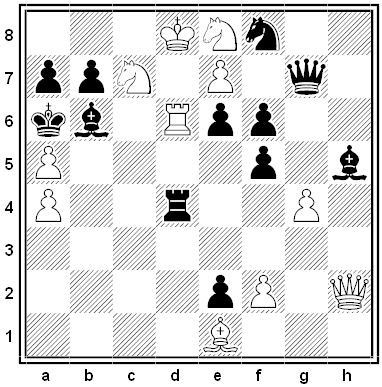
From T.R. Dawson, a logic problem posing as a chess puzzle. If pinned men do not check, how can White mate in two moves?
|
SelectClick for Answer |
The black rook on d4 pins the white rook on d6, so the black bishop on b6 is free to move, and this means that the white knight on c7 is pinned and not checking the black king. White plays 1. f3, threatening to take the e2 pawn with his queen. This would be mate — it’s no use blocking the queen’s check with the d4 rook, because this reverses the chain of pins — now the pinned d3 rook doesn’t check, so the d6 rook does, the b6 bishop doesn’t, and the c7 knight does, giving mate anyway! Likewise:
1. f3 Rd5 2. Qxe2# (same idea as above — 2. … Rb5 is ineffective)
1. f3 Bxa5 2. Kc8#
1. f3 Bxc7 2. Nxc7#
1. f3 Bxe8 2. Kxe8#
1. f3 Qxe7+ 2. Kxe7#
1. f3 Rd2 2. Bxd2#
1. f3 Rxd6+ 2. Qxd6#
Dawson wrote, “The idea amounts to ‘discovering mate’ from c7.” He dedicated the puzzle to Eduard Birgfeld. From Caissa’s Wild Roses, 1935.
|

